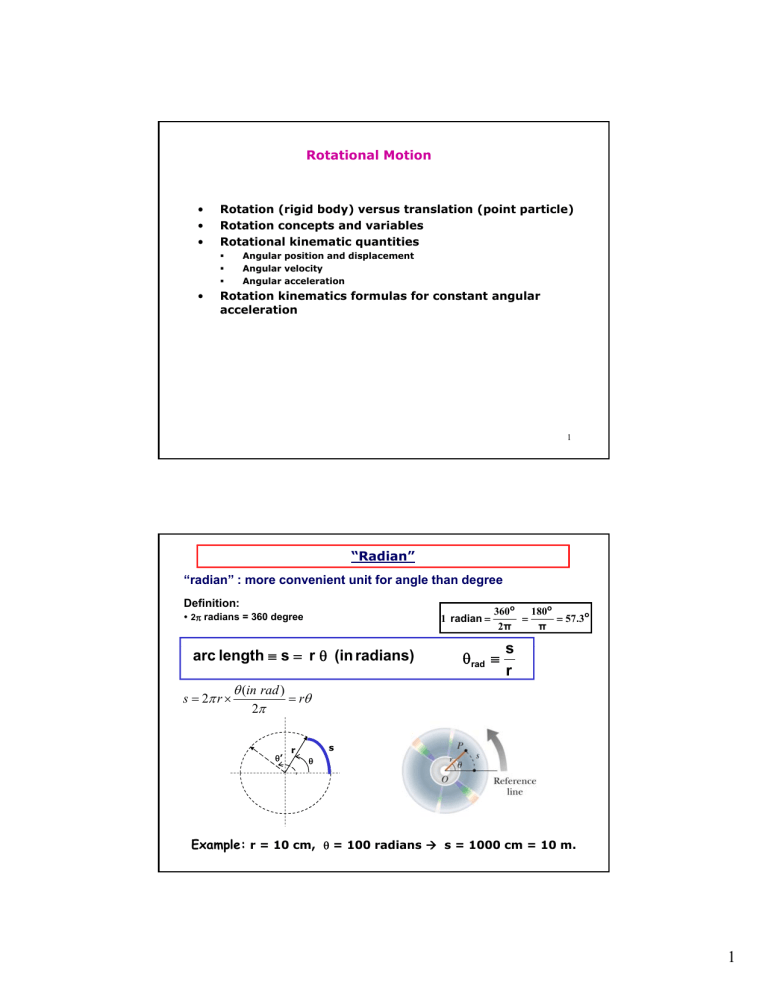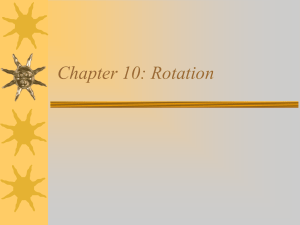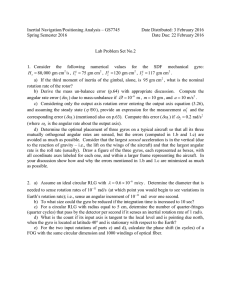s radians) (in r s length arc θ = ≡ r s θ

Rotational Motion
• Rotation (rigid body) versus translation (point particle)
• Rotation concepts and variables
• Rotational kinematic quantities
Angular position and displacement
Angular velocity
Angular acceleration
• Rotation kinematics formulas for constant angular acceleration
1
“Radian”
“radian” : more convenient unit for angle than degree
Definition:
• 2
π radians = 360 degree 1 radian =
360
2 π o
=
180 o
π
= 57 .
3 o arc length ≡ s = r θ (in radians) θ rad
≡ r s
= 2 π r
×
θ
2 π
= r
θ
θ ’ r s
Example: r = 10 cm, θ = 100 radians Æ s = 1000 cm = 10 m.
1
Rigid body
Rigid body:
A “rigid” object, for which the position of each point relative to all other points in the body does not change.
Example:
Solid: Rigid body
Liquid: Not rigid body
Rigid body can still have translational and rotational motion.
Angular position of rotating rigid body
• By convention, θ is measured CCW from the x-axis
• It keeps increasing past 2 π , can be y
• Each point of the body moves around the axis in a circle with some specific radius rotation axis “o” fixed to body parallel to z-axis
θ x
Reference line rotates with body rigid body
2
Angular displacement of rotating rigid body y
Angular displacement:
• Net change in the angular coordinate
Δ θ ≡ θ final
− θ inital
(an angle in rad.)
Arc length: Δ s
• Measures distance covered by a point as it moves through Δθ (constant r)
Δ s ≡ r Δ θ
(a distance along a circular arc) rotation axis “o” fixed to body parallel to z-axis
θ x
Reference li t t with body rigid body
Reference line rotating with body y
Δ s = r Δθ r
θ f
θ o x r
Rigid body rotation: angular & tangential velocity
Angular velocity ω :
• Rate of change of the angular displacement
ω ave
≡
Δ
Δ
θ t
ω inst
≡
Δ
Lim t → 0
Δ
Δ
θ t
≡ d θ dt
• Units: radians/sec. Positive in Counter-Clock-Wise sense
For any point, r is the perpendicular distance to the rotation axis v
T
• Frequency f = # of complete revolutions/unit time
• f = 1/T T = period (time for 1 complete revolution r
θ = ωΔτ
ω = 2 π f = 2 π /T f = ω /2 π x
Tangential velocity v
T:
• Rate at which a point sweeps out arc length along circular path s r
θ
Æ
Δ
Δ t s
= r
Δ
Δ
θ t
Æ v
T
= r
ω
3
iClicker Quiz
1.1. The period of a rotating wheel is 12.57 seconds. The radius of the wheel is 3 meters. It ’ s angular speed is closest to:
A.
79 rpm
B.
d/
C.
2.0 rad/s
D.
.08 rev/s
E.
6.28 rev/s
1.2. A point on the rim of the same wheel has a tangential speed closest to:
A.
12.57 rev/s
B.
0.8 rev/s
C.
0.24 m/s
D.
1.5 m/s
E.
6.28 m/s v
Δ s ≡ r Δ θ
T
= ω r
ω = 2 π f = 2 π /T
Rigid body rotation: angular acceleration
Angular acceleration α:
• Rate of change of the angular velocity
• Units: rad/s 2
• CCW considered positive
• for CONSTANT α: ω f
= ω
0
+ α Δ t
α ave
≡
Δ ω
Δ t
α inst
≡
Lim t 0
Δ ω
Δ t
= d
ω dt
4
1D and Angular Kinematics Equations
(Same mathematical forms)
1D motion with constant acceleration a x(t), v(t), a(t)
Angular motion with constant angular acceleration α variables θ( t ), ω( t ), α( t ) v = dx dt a = dv dt
Definitions ω = d θ dt
α = d ω dt v f
( t ) = v
0
+ at v x f
( t ) = f f
2 ( ( t ) = v x
0
+ v
0 t +
2
0
+ 2 a [ [ x f f
1
2 at 2
− x ] ]
Kinematic
Equations
ω f
( t ) = ω
0
+ α t
θ f
( t ) = θ
0
+ ω
0 t +
1
2
α t 2 f f
2
( ( t t ) ) = 2
0
2 α [ f f
− ] ]
Rotational variables are vectors, having direction
The angular displacement, speed, and acceleration
( θ, ω , α ) are vectors with direction.
The directions are given by the right-hand rule:
Fingers of right hand curl along the angular direction (See Fig.)
Then, the direction of thumb is h di quantity.
f h l
5
Example:
A grindstone is rotating with constant angular acceleration about a fixed axis in space.
Initial conditions at t = 0:
α = 0.35
rad/s
2 ω
0
= 4.6
rad/s
When is Δ
θ
= 0 again in addition to t=0?
Positive directions: right hand rule
Example: Wheel rotating and accelerating
At t = 0, a wheel rotating about a fixed axis at a constant angular acceleration has an angular velocity of 2.0 rad/s. Two seconds later it has turned through 5.0 complete revolutions. Find the angular acceleration of this wheel?
ω f
( t ) = ω
0
+ α t
θ f
( t ) = θ
0
+ ω
0 t +
1
2
α t
2
ω f
2
( t ) = ω 2
0
+ 2 α [ θ f
− θ
0
]
6
Rigid body rotation: radial and tangential acceleration
Centripetal (radial) acceleration a c or a r
• Radial acceleration component, points toward rotation axis a r
= v
T
2 r
= ω 2 r (use v
T
= ω r
)
F r
= ma r a c v
ω,α a
T r x
Tangential acceleration a
T
:
• Tangential acceleration component
• Proportional to angular acceleration α and also to radius r
• Units: length / time 2 a
T
= F tangential
= ma
T
Rotation variables: angular vs. linear s
= r Δθ v
T
= r ω a
T
= r
α
a r
=
v
T
2
ω
2
7
A ladybug sits at the outer edge of a merry-go-round, and a gentleman bug sits halfway between her and the axis of rotation. The merry-go-round makes a complete revolution once each second. The gentleman bug’s angular velocity is
A. half the ladybug’s.
B. the same as the ladybug’s.
C. twice the ladybug’s.
D. impossible to determine
A ladybug sits at the outer edge of a merry-go-round, and a gentleman bug sits halfway between her and the axis of rotation. The merry-go-round makes a complete revolution once each second. The gentleman bug’s velocity is
A. half the ladybug’s.
B. the same as the ladybug’s.
C. twice the ladybug’s.
D. impossible to determine
8
Rotational Dynamics
We want something like “F=ma” for rotational motion…..
• Moment of inertia – rotational analog of mass
• Torque – rotational analog of force
17
Something like mass for rotational motion: Moment of Inertia, I
G
L
Kinetic energy of ladybug and gentlemanbug
K
=
1
2
=
2
2 +
1
2
2 ω 2 +
2
2 =
2 ω 2
1
2 m r
L
ω ) 2
=
2
(
+
1
2 m r
G
ω ) 2 m r
2 + m r
2
)
ω 2 =
I
=
m r
2
L L
+
m r
2
G G
Generally, I
= m r
2 + m r
2 + m r
2 + ...
2
I
ω 2
Kinetic energy: K
=
1
2
I
ω 2
9
Example: Find moment of inertia for a crossed dumbbell
• Four identical balls as shown: m = 2 kg
• Connected by massless rods: length d = 1 m.
m m
B d d
A d
2 d
C m
Rotational inertia I depends on axis chosen m
A) Choose rotation axis perpendicular to figure through point “A” h i di l t fi th h i t “B”
C) Let rotation axis pass through points “B” and “C”
Calculation of Moment of inertia for continuous mass distributions requires “Integration, a kind of calculus”.
We will just use the result.
10
Moments of Inertia of Various Rigid Objects
Now we want to define “torque, τ ”, so that “ τ = I α ”.
Since
F
T
F
θ m
Newton’s Law along tangential direction
F
T
= ma
T
= m r
α
Multiplying “r”, so that we have “I” on right side axis r p
F
T
=
F sin θ rF
T
= m r
2
So, let’s define torque as
α =
I
α
τ
≡ rF
T
Then we got
τ =
I
α and r p
=
r sin
θ
τ = rF
T
= rF sin θ = r F p
(could be positive or negative)
11
F
T
F
θ m r r p axis
τ = rF
T
= rF sin θ =
If r = 0, torque is zero.
If theta = 0 or 180 degree, the torque is zero.
For multiple forces
τ
net
τ τ τ
3
τ
net
=
I
α
...
m
1 m
2 m1=100 kg adult, m2=10 kg baby.
Distance to fulcrum point is 1 m and 11 m respectively.
t t t h i t l
Which direction will it rotates?
iti f t
(a) Counter-Clockwise
(b) Clockwise
(c) No rotation
(d) Not enough information
Example: Find the net torque, moment of inertia, and initial angular acceleration.
Choose axis of rotation through fulcrum point.
12
Example: second law for rotation
PP10606-49*
:
When she is launched from a springboard, a diver's angular speed about her center of mass changes from zero to 6.20 rad/s in 220 ms. Her rotational inertia about her center of mass is constant at 12.0 kg·m 2 . During the launch, what are the magnitudes of (a) her average angular acceleration and (b) the average external torque on her from the board?
G net
= I tot
G
5 N tangential force is applied at the edge of a uniform disk of radius 2 m and mass of 8 kg.
Find angular acceleration.
F=5 N
Formula:
=
1
I MR
2
2
Axis of rotation
13
5 N tangential force is applied at 1 m from the center of a uniform disk of radius 2 m and mass of 8 kg.
Find angular acceleration.
Formula:
=
1
I MR
2
2
Axis of rotation
5 N force is applied at 1 m from the center of a uniform disk of radius 2 m and mass of 8 kg.
Find torque.
45 degree
F=5 N
Axis of rotation
14
Torque on extended object by gravitational force
Æ Assume that the total gravitational force effectively acts at the center of mass.
Gravitational potential energy of extended object
Æ M g H, where H is the height of the center of mass and M is the total mass.
iClicker Q
Axis of rotation l if of length L & mass M d
Find the torque by gravitational force.
A. LMg
B. (L/2)Mg
C. 2LMg
D. (3/2)LMg
E. None of the above
Find the angular acceleration.
I
=
1
3
ML
2
15
Example of energy conservation
Axis of rotation
Horizontal uniform rod of length L & mass M is released from rest.
Find its angular speed at the lowest point, assuming no friction between axis of rotation and the rod.
Example
A thin uniform rod (length = 1.2 m, mass = 2.0 kg) is pivoted about a horizontal, frictionless pin through one end of the rod. (The moment of inertia of the rod about this axis is ML 2 /3.) The rod is released when it makes an angle of 37° with the horizontal. What is the angular acceleration of the rod at the instant it is released?
16
Example: Torque and Angular Acceleration of a Wheel
•Cord wrapped around disk, hanging weight
• Cord does not slip or stretch g, g, m
• Find acceleration of mass m, find angular acceleration α for disk, tension, and torque on the disk a
Formula: I =
2
Mr mg r
Rolling : motion with translation and rotation about center of mass
ω
K total
=
K rot
+
K cm
K
=
1
I
ω
2 v cm
U
K cm
=
1
2
Mv
2 cm gravity
=
Mgh cm
E mech
=
K tot
+
U
Δ
E mech
=
W
For rolling without slipping s R v cm
=
R
ω
θ
17
Example: Use energy conservation to find the speed of the bowling ball as it rolls w/o slipping to the bottom of the ramp
Given: h=2m
Hint:
Formula: For a solid sphere
I cm
= 2
5
MR
2
Rotation accelerates if there is friction between the sphere and the ramp
Friction force produces the net torque and angular acceleration.
There is no mechanical energy change because the contact point is always at rest relative to the surface, so no work is done against friction iClicker Q:
A solid sphere and a spherical shell of the same radius r and same mass M roll to the bottom of a ramp without slipping from the same height h.
True or false? : “The two have the same speed at the bottom.”
A) True
B) False. Shell is faster.
C) False. Solid sphere is faster.
D) Not enough information.
I_(cm, spherical shell) = (2/3) MR^2
I_(cm, solid sphere)=(2/5) MR^2
18





